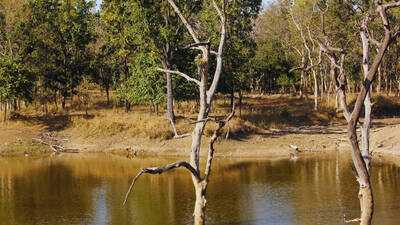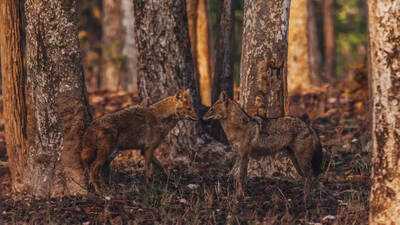“Kanha National Park, the inspiration behind Rudyard Kipling’s famous book called The Jungle Book…”
“Pench National Park, inspired by Kipling’s The Jungle Book…”
We have certainly come across these two claims. But which one is it? It can’t be both, or can it?
Well, in this case, it is not true. Nestled in the heart of Madhya Pradesh, Pench National Park is a verdant haven that has inspired countless wildlife enthusiasts, nature lovers, and even literary giants. This is the forest that inspired Rudyard Kipling’s The Jungle Book, where the adventures of Mowgli, Baloo, Bagheera, and Shere Khan came to life.
As per the forest department’s website, the forests of Pench Tiger Reserve and its surrounding landscapes are widely regarded as the real-life setting of Rudyard Kipling’s classic, The Jungle Book. The inspiration for Mowgli’s character is believed to have stemmed from a documented account titled “An Account of Wolves Nurturing Children in Their Dens” by Sir William Henry Sleeman, which described incidents of wolf-raised children in central India.
In fact, in 1831, a report came out about a child found living with wolves in the village of Satbavadi near Seoni. Many of the places vividly portrayed in The Jungle Book, such as the Vainganga River, the valley where Shere Khan meets his end, and the mountain ranges near the villages of Kanhiwada and Seoni, they all are actual locations in the Seoni district.

Pench National Park straddles the Madhya Pradesh-Maharashtra border, covering an area of approximately 758 square kilometres The core zone comprises around 299 square kilometres. The park derives its name from the Pench River, which winds its way through the forest. Pench is, without a doubt, one of the most photogenic national parks in India. The forests here are a mix of dense woods, open meadows, and riverine belts. The gentle winding riverside looks stunning during sunset. Every safari trip gives stunning photo-ops that one just cannot ignore. Come for the tiger, other wildlife, the lush forest or the sunset, you will not be disappointed.
The park is home to over 25 species of mammals, including the iconic Bengal tiger, leopard, sloth bear, wild dog or dholes, and sambar deer. Good news for birdwatchers, as the national park is home to over 200 species of birds, both resident and migratory. It doesn’t matter where you enter from, be it Madhya Pradesh’s side or Maharashtra’s side, the experiences are always fantastic.
Wildlife safaris in Pench National Park and Tiger ReserveThe most popular activity in Pench is the safari, which allows visitors to witness the forest’s incredible biodiversity firsthand. The park offers both jeep safaris and canter rides, organised twice daily, early morning and late afternoon, when wildlife activity is at its peak. There are three entry points (Gate) for the core zone, and they are Turia, Karmajhiri, and Jamtara. There are several other gates from both the Madhya Pradesh and Maharashtra side. The nearest airports being Jabalpur in Madhya Pradesh, and Nagpur in Maharashtra. For those travelling by train, the closest railway station is Seoni, about 30 km from the park’s main entrance. Nagpur also serves as a major rail hub. For those on a self-drive holiday, Pench is accessible via well-maintained roads from Nagpur, Jabalpur, and Seoni. State transport buses and private taxis are also readily available.
 The dense forests, grassy meadows, and riverbanks make every safari a unique adventure. Many visitors are fortunate enough to catch sight of a tiger or leopard in its natural habitat. And if you are fortunate enough to spot a rock python, sloth bear and a black panther, you will have your own Jungle Book moment!
The dense forests, grassy meadows, and riverbanks make every safari a unique adventure. Many visitors are fortunate enough to catch sight of a tiger or leopard in its natural habitat. And if you are fortunate enough to spot a rock python, sloth bear and a black panther, you will have your own Jungle Book moment!
For those visiting for the first time, Pench National Park is well-equipped for tourists, and at the same time does not compromise on the safety of the wildlife. Several eco-friendly resorts and lodges are located on the outskirts, providing comfortable accommodation while maintaining proximity to the forest.
Best time to visitThe ideal period to explore Pench is from November to June. Winter (November to February) is the best time for wildlife spotting. The temperature is cooler and the animals are more visible near water sources as this is also the dry season. Summer (March to June) can get a little too hot, but that also means the animals will gather more frequently around waterholes.
Monsoon (July to September) is when the park remains closed due to heavy rains. The forest is denser this time of the year and the tracks are all muddy, unsafe for safaris.
Visiting Pench is more than just a wildlife excursion. Whether you are a wildlife enthusiast, a family seeking adventure, a photographer chasing rare shots, or a Jungle Book fan eager to experience Kipling’s forest firsthand, Pench National Park offers a journey that satisfies every expectation.
“Pench National Park, inspired by Kipling’s The Jungle Book…”
We have certainly come across these two claims. But which one is it? It can’t be both, or can it?
Well, in this case, it is not true. Nestled in the heart of Madhya Pradesh, Pench National Park is a verdant haven that has inspired countless wildlife enthusiasts, nature lovers, and even literary giants. This is the forest that inspired Rudyard Kipling’s The Jungle Book, where the adventures of Mowgli, Baloo, Bagheera, and Shere Khan came to life.
As per the forest department’s website, the forests of Pench Tiger Reserve and its surrounding landscapes are widely regarded as the real-life setting of Rudyard Kipling’s classic, The Jungle Book. The inspiration for Mowgli’s character is believed to have stemmed from a documented account titled “An Account of Wolves Nurturing Children in Their Dens” by Sir William Henry Sleeman, which described incidents of wolf-raised children in central India.
In fact, in 1831, a report came out about a child found living with wolves in the village of Satbavadi near Seoni. Many of the places vividly portrayed in The Jungle Book, such as the Vainganga River, the valley where Shere Khan meets his end, and the mountain ranges near the villages of Kanhiwada and Seoni, they all are actual locations in the Seoni district.
Pench National Park straddles the Madhya Pradesh-Maharashtra border, covering an area of approximately 758 square kilometres The core zone comprises around 299 square kilometres. The park derives its name from the Pench River, which winds its way through the forest. Pench is, without a doubt, one of the most photogenic national parks in India. The forests here are a mix of dense woods, open meadows, and riverine belts. The gentle winding riverside looks stunning during sunset. Every safari trip gives stunning photo-ops that one just cannot ignore. Come for the tiger, other wildlife, the lush forest or the sunset, you will not be disappointed.
The park is home to over 25 species of mammals, including the iconic Bengal tiger, leopard, sloth bear, wild dog or dholes, and sambar deer. Good news for birdwatchers, as the national park is home to over 200 species of birds, both resident and migratory. It doesn’t matter where you enter from, be it Madhya Pradesh’s side or Maharashtra’s side, the experiences are always fantastic.
Wildlife safaris in Pench National Park and Tiger ReserveThe most popular activity in Pench is the safari, which allows visitors to witness the forest’s incredible biodiversity firsthand. The park offers both jeep safaris and canter rides, organised twice daily, early morning and late afternoon, when wildlife activity is at its peak. There are three entry points (Gate) for the core zone, and they are Turia, Karmajhiri, and Jamtara. There are several other gates from both the Madhya Pradesh and Maharashtra side. The nearest airports being Jabalpur in Madhya Pradesh, and Nagpur in Maharashtra. For those travelling by train, the closest railway station is Seoni, about 30 km from the park’s main entrance. Nagpur also serves as a major rail hub. For those on a self-drive holiday, Pench is accessible via well-maintained roads from Nagpur, Jabalpur, and Seoni. State transport buses and private taxis are also readily available.
For those visiting for the first time, Pench National Park is well-equipped for tourists, and at the same time does not compromise on the safety of the wildlife. Several eco-friendly resorts and lodges are located on the outskirts, providing comfortable accommodation while maintaining proximity to the forest.
Best time to visitThe ideal period to explore Pench is from November to June. Winter (November to February) is the best time for wildlife spotting. The temperature is cooler and the animals are more visible near water sources as this is also the dry season. Summer (March to June) can get a little too hot, but that also means the animals will gather more frequently around waterholes.
Monsoon (July to September) is when the park remains closed due to heavy rains. The forest is denser this time of the year and the tracks are all muddy, unsafe for safaris.
Visiting Pench is more than just a wildlife excursion. Whether you are a wildlife enthusiast, a family seeking adventure, a photographer chasing rare shots, or a Jungle Book fan eager to experience Kipling’s forest firsthand, Pench National Park offers a journey that satisfies every expectation.
You may also like

100 yrs of Indian Hockey: Trilochan Singh Bawa's medals serve as a motivation for us at home, says son Sukhwinder Bawa

Storm Benjamin gardeners urged to do three key things before bad weather hits

Louvre loot: Who buys a stolen crown? Inside the global black market for royal jewels

Gujarat: Police rescue 6-month-old kidnapped near Kalol

Oxford Union chaos as debater met with 'hatred and abuse' over Israel-Gaza row





